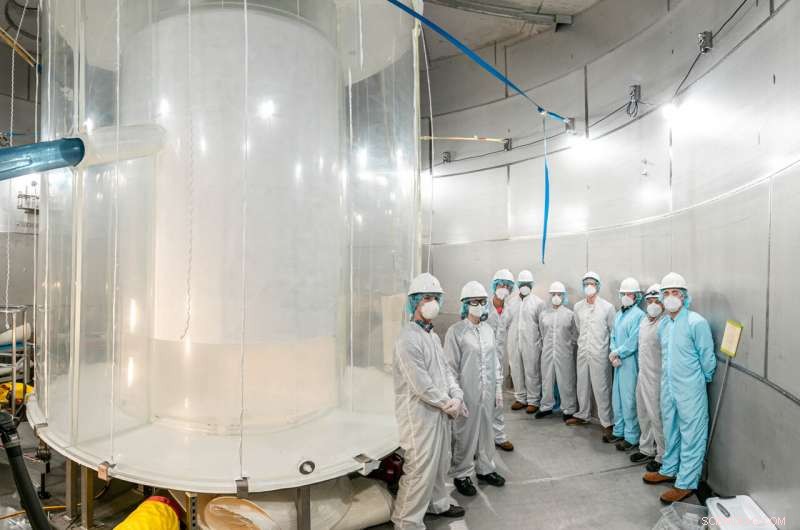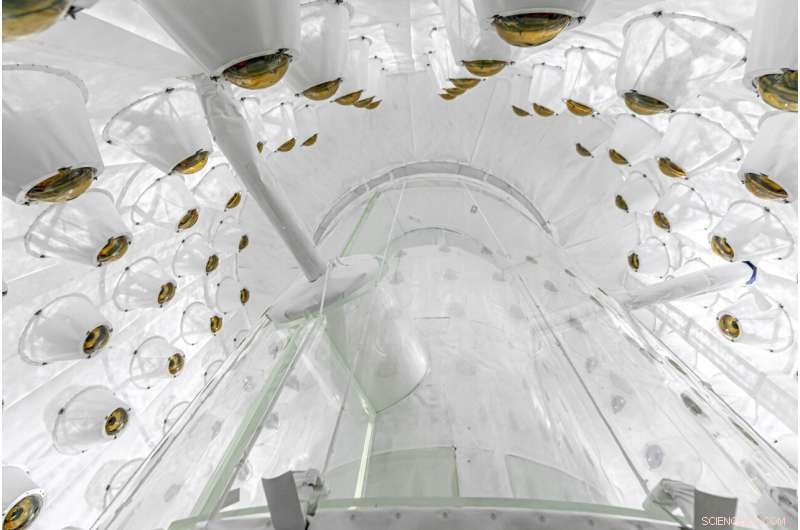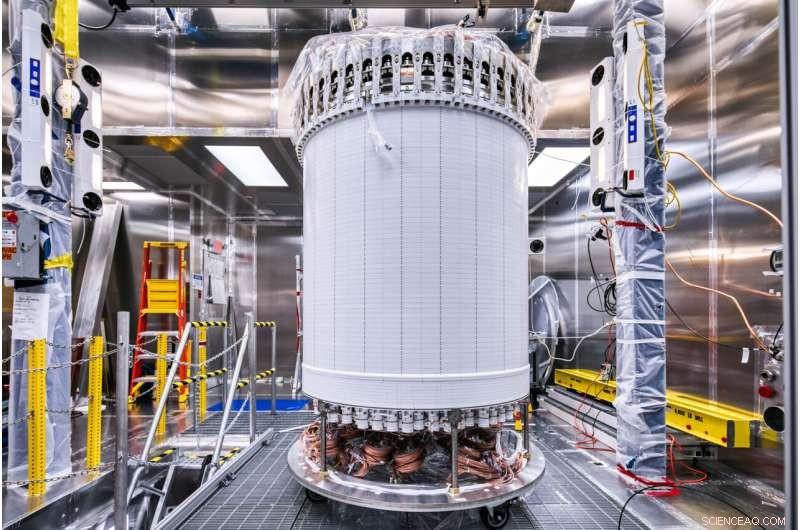
Membres de l'équipe LZ dans le réservoir d'eau LZ après l'installation du détecteur extérieur. Crédit :Matthew Kapust/Installation de recherche souterraine de Sanford
Au fond des Black Hills du Dakota du Sud, dans le Sanford Underground Research Facility (SURF), un détecteur de matière noire innovant et d'une sensibilité unique - l'expérience LUX-ZEPLIN (LZ), dirigée par Lawrence Berkeley National Lab (Berkeley Lab) - a passé un phase de vérification des opérations de démarrage et a livré les premiers résultats.
Le message à retenir de cette startup à succès :"Nous sommes prêts et tout va bien", a déclaré Kevin Lesko, physicien senior du Berkeley Lab et ancien porte-parole de LZ. "C'est un détecteur complexe avec de nombreuses pièces et elles fonctionnent toutes bien dans les attentes", a-t-il déclaré.
Dans un article publié aujourd'hui en ligne sur le site Web de l'expérience, les chercheurs de LZ rapportent qu'avec la première exécution, LZ est déjà le détecteur de matière noire le plus sensible au monde. Le document apparaîtra sur les archives de préimpression en ligne arXiv.org plus tard dans la journée. Le porte-parole de LZ, Hugh Lippincott, de l'Université de Californie à Santa Barbara, a déclaré :"Nous prévoyons de collecter environ 20 fois plus de données dans les années à venir, donc nous ne faisons que commencer. Il y a beaucoup de science à faire et c'est très excitant."
Les particules de matière noire n'ont jamais été détectées, mais peut-être plus depuis longtemps. Le compte à rebours a peut-être commencé avec les résultats des 60 premiers "jours en direct" de tests de LZ. Ces données ont été recueillies sur une période de trois mois et demi d'opérations initiales commençant fin décembre. Ce fut une période suffisamment longue pour confirmer que tous les aspects du détecteur fonctionnaient bien.
Invisible, parce qu'elle n'émet, n'absorbe ou ne diffuse pas de lumière, la présence et l'attraction gravitationnelle de la matière noire sont néanmoins fondamentales pour notre compréhension de l'univers. Par exemple, la présence de matière noire, estimée à environ 85 % de la masse totale de l'univers, façonne la forme et le mouvement des galaxies, et elle est invoquée par les chercheurs pour expliquer ce que l'on sait de la structure et de l'expansion à grande échelle. de l'univers.

Regarder dans le détecteur extérieur LZ, utilisé pour opposer son veto à la radioactivité qui peut imiter un signal de matière noire. Crédit :Matthew Kapust/Installation de recherche souterraine de Sanford
Le cœur du détecteur de matière noire LZ est composé de deux réservoirs en titane imbriqués remplis de dix tonnes de xénon liquide très pur et visualisés par deux réseaux de tubes photomultiplicateurs (PMT) capables de détecter de faibles sources de lumière. Les réservoirs en titane résident dans un système de détection plus grand pour attraper les particules qui pourraient imiter un signal de matière noire.
"I'm thrilled to see this complex detector ready to address the long-standing issue of what dark matter is made of," said Berkeley Lab Physics Division Director Nathalie Palanque-Delabrouille. "The LZ team now has in hand the most ambitious instrument to do so."
The design, manufacturing, and installation phases of the LZ detector were led by Berkeley Lab project director Gil Gilchriese in conjunction with an international team of 250 scientists and engineers from over 35 institutions from the US, UK, Portugal, and South Korea. The LZ operations manager is Berkeley Lab's Simon Fiorucci. Together, the collaboration is hoping to use the instrument to record the first direct evidence of dark matter, the so-called missing mass of the cosmos.
Henrique Araújo, from Imperial College London, leads the UK groups and previously the last phase of the UK-based ZEPLIN-III program. He worked very closely with the Berkeley team and other colleagues to integrate the international contributions. "We started out with two groups with different outlooks and ended up with a highly tuned orchestra working seamlessly together to deliver a great experiment," Araújo said.
An underground detector
Tucked away about a mile underground at SURF in Lead, S.D., LZ is designed to capture dark matter in the form of weakly interacting massive particles (WIMPs). The experiment is underground to protect it from cosmic radiation at the surface that could drown out dark matter signals.

(Left) A schematic of the LZ detector. (Right) Illustration of LZ operation—particles interact in liquid xenon, releasing a flash of light and charge that are collected by photomultiplier tube arrays at top and bottom. Credit:Left schematic:LZ collaboration. Right image:LZ/SLAC
Particle collisions in the xenon produce visible scintillation or flashes of light, which are recorded by the PMTs, explained Aaron Manalaysay from Berkeley Lab, who as physics coordinator, led the collaboration's efforts to produce these first physics results. "The collaboration worked well together to calibrate and to understand the detector response," Manalaysay said. "Considering we just turned it on a few months ago and during COVID restrictions, it is impressive we have such significant results already."
The collisions will also knock electrons off xenon atoms, sending them to drift to the top of the chamber under an applied electric field where they produce another flash permitting spatial event reconstruction. The characteristics of the scintillation help determine the types of particles interacting in the xenon.
Mike Headley, executive director of SURF Lab, said, "The entire SURF team congratulates the LZ Collaboration in reaching this major milestone. The LZ team has been a wonderful partner and we're proud to host them at SURF."
Fiorucci said the onsite team deserves special praise at this startup milestone, given that the detector was transported underground late in 2019, just before the onset of the COVID-19 pandemic. He said with travel severely restricted, only a few LZ scientists could make the trip to help on site. The team in South Dakota took excellent care of LZ.
"I'd like to second the praise for the team at SURF and would also like to express gratitude to the large number of people who provided remote support throughout the construction, commissioning and operations of LZ, many of whom worked full time from their home institutions making sure the experiment would be a success and continue to do so now," said Tomasz Biesiadzinski of SLAC, the LZ detector operations manager.

The LZ central detector in the clean room at Sanford Underground Research Facility after assembly, before beginning its journey underground. Credit:Matthew Kapust, Sanford Underground Research Facility
"Lots of subsystems started to come together as we started taking data for detector commissioning, calibrations and science running. Turning on a new experiment is challenging, but we have a great LZ team that worked closely together to get us through the early stages of understanding our detector," said David Woodward from Pennsylvania State University, who coordinates the detector run planning.
Maria Elena Monzani of SLAC, the Deputy Operations Manager for Computing and Software, said, "We had amazing scientists and software developers throughout the collaboration, who tirelessly supported data movement, data processing, and simulations, allowing for a flawless commissioning of the detector. The support of NERSC [National Energy Research Scientific Computing Center] was invaluable."
With confirmation that LZ and its systems are operating successfully, Lesko said, it is time for full-scale observations to begin in hopes that a dark matter particle will collide with a xenon atom in the LZ detector very soon. A major milestone for an underground dark matter search experiment